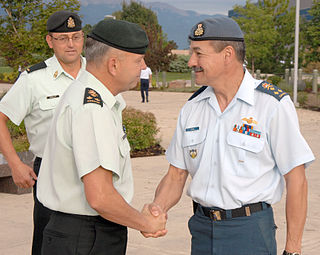| Rear admiral | |
|---|---|
 The RADM insignia | |
 | |
| Country | |
| Service branch | |
| Abbreviation | RADM |
| Rank | Two-star |
| NATO rank | OF-7 |
| Non-NATO rank | O-8 |
| Next higher rank | Vice admiral |
| Next lower rank | Commodore |
| Equivalent ranks | |
Rear admiral (abbreviated as RADM) is the third-highest active rank of the Royal Australian Navy and was created as a direct equivalent of the British rank of rear admiral. It is a two-star rank.

The Royal Australian Navy (RAN) is the naval branch of the Australian Defence Force. Following the Federation of Australia in 1901, the ships and resources of the separate colonial navies were integrated into a national force, called the Commonwealth Naval Forces. Originally intended for local defence, the navy was granted the title of 'Royal Australian Navy' in 1911, and became increasingly responsible for defence of the region.

The United Kingdom of Great Britain and Northern Ireland, commonly known as the United Kingdom (UK) or Britain, is a sovereign country located off the north-western coast of the European mainland. The United Kingdom includes the island of Great Britain, the north-eastern part of the island of Ireland, and many smaller islands. Northern Ireland is the only part of the United Kingdom that shares a land border with another sovereign state, the Republic of Ireland. Apart from this land border, the United Kingdom is surrounded by the Atlantic Ocean, with the North Sea to the east, the English Channel to the south and the Celtic Sea to the south-west, giving it the 12th-longest coastline in the world. The Irish Sea separates Great Britain and Ireland. The United Kingdom's 242,500 square kilometres (93,600 sq mi) were home to an estimated 66.0 million inhabitants in 2017.

An officer of two-star rank is a senior commander in many of the armed services holding a rank described by the NATO code of OF-7. The term is also used by some armed forces which are not NATO members. Typically, two-star officers hold the rank of rear admiral, counter admiral, major general, or in the case of those air forces with a separate rank structure, air vice-marshal.
Contents
Rear admiral is a higher rank than commodore, but lower than vice admiral. Rear admiral is the equivalent of air vice-marshal in the Royal Australian Air Force and major general in the Australian Army.
Vice admiral is the second-highest active rank of the Royal Australian Navy and was created as a direct equivalent of the British rank of vice admiral. It is a three-star rank. The rank is held by the Chief of Navy and, when the positions are held by navy officers, by the Vice Chief of the Defence Force, the Chief of Joint Operations, or the Chief Capability Development Group.
Air vice-marshal is the third highest active rank of the Royal Australian Air Force and was created as a direct equivalent of the British Royal Air Force rank of air vice-marshal. It is also considered a two-star rank. The Australian Air Corps adopted the RAF rank system on 9 November 1920 and this usage was continued by its successor, the Royal Australian Air Force.

The Royal Australian Air Force (RAAF), formed in March 1921, is the aerial warfare branch of the Australian Defence Force (ADF). It operates the majority of the ADF's fixed wing aircraft, although both the Australian Army and Royal Australian Navy also operate aircraft in various roles. It directly continues the traditions of the Australian Flying Corps (AFC), formed on 22 October 1912. The RAAF provides support across a spectrum of operations such as air superiority, precision strikes, intelligence, surveillance and reconnaissance, air mobility, space surveillance, and humanitarian support.
Since the mid-1990s, the insignia of a Royal Australian Navy vice admiral is the Crown of St. Edward above a crossed sabre [lower-alpha 1] and baton, above two silver stars, above the word "AUSTRALIA". [1] The stars have eight points [lower-alpha 2] as in the equivalent Royal Navy insignia. Prior to 1995, the RAN shoulder board was identical to the UK shoulder board. The UK shoulder board changed in 2001.
Rear Admiral Robyn Walker AM , RAN became the first female admiral in the Royal Australian Navy when she was appointed Surgeon-General of the Australian Defence Force on 16 December 2011. [2]
Rear Admiral Robyn Margaret Walker, is an Australian medical practitioner and a retired senior officer of the Royal Australian Navy (RAN). Walker became the first female admiral in the RAN when she was appointed Surgeon-General of the Australian Defence Force on 16 December 2011.

The Australian Defence Force (ADF) is the military organisation responsible for the defence of Australia. It consists of the Royal Australian Navy (RAN), Australian Army, Royal Australian Air Force (RAAF) and a number of "tri-service" units. The ADF has a strength of just under 80,000 full-time personnel and active reservists, and is supported by the Department of Defence and several other civilian agencies.





